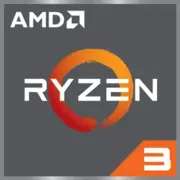AMD Ryzen 3 2200G

AMD Ryzen 3 2200G: Budget APU for Basic Tasks and Light Gaming
Relevant as of April 2025
Key Specifications: Raven Ridge Architecture and Performance Balance
The AMD Ryzen 3 2200G processor, released in 2018, remains a popular choice for budget PCs due to its well-balanced combination of CPU and GPU on a single chip.
- Architecture and Process:
Based on the first generation Zen microarchitecture with a 14 nm process. Codename — Raven Ridge. It features four cores and four threads (without SMT), with a base clock speed of 3.5 GHz and a turbo mode of up to 3.7 GHz.
- Integrated Graphics:
Radeon Vega 8 with 8 Compute Units (512 stream processors) and a frequency of up to 1100 MHz. This is a key feature — the APU can handle light gaming without the need for a discrete graphics card.
- Cache and TDP:
L3 cache is 4 MB, and the thermal design power (TDP) is 65 W. These modest figures are sufficient for basic tasks.
- Performance:
In the Geekbench 6 benchmark (2025), it scores 768 points in single-threaded and 1420 in multi-threaded mode. For comparison, modern budget CPUs like the Ryzen 3 5300G show 40-60% higher results.
Compatible Motherboards: AM4 Socket and Selection Nuances
The Ryzen 3 2200G uses the AM4 socket, which gives access to a wide range of motherboards, including models from 2017 to 2022.
- Chipsets:
Supports A320, B350, X370, B450, X470. A video output on the motherboard (HDMI, DVI, DisplayPort) is required to activate the APU (integrated graphics).
- Features:
- A320/B350 boards may require a BIOS update to work with the Ryzen 2000G. By 2025, most new boards available for sale already have up-to-date firmware.
- For overclocking (unofficially supported on B350/X370), it's better to choose models with VRM heatsinks, such as the MSI B450 Tomahawk Max ($90-110).
- Recommendations:
A budget option is the ASRock A320M-HDV ($55-65). For potential future upgrades, look for B450 boards (Gigabyte B450M DS3H, $75-85).
Supported Memory: DDR4 and the Importance of Dual-Channel Mode
The Ryzen 3 2200G works only with DDR4.
- Frequencies:
Officially supports modules up to 2933 MHz. However, many boards allow the activation of XMP profiles for 3200 MHz.
- Dual-Channel Mode:
Dual-channel mode is critically important for integrated graphics. For example, a pair of DDR4-2666 8 GB modules (2x4 GB) can provide a 15-25% FPS boost in games compared to single-channel.
- Recommended Size:
A minimum of 8 GB (2x4 GB) is needed, while 16 GB (2x8 GB) is optimal. In 2025, a 16 GB DDR4-3200 kit costs $40-50.
Power Supply: Power Calculation and Reliability
With a TDP of 65 W, the Ryzen 3 2200G does not require a powerful PSU.
- Without a Discrete Graphics Card:
A power supply unit (PSU) of 350-450 W is sufficient. For instance, the EVGA 450 BR ($45) or be quiet! System Power 10 400W ($50).
- With a Graphics Card:
When adding a GPU like the NVIDIA GTX 1650 (TDP 75 W), a 500 W PSU will be required (Corsair CX550M, $65).
- Important:
Do not skimp on the PSU — unstable power can cause issues with the Vega 8.
Pros and Cons of the Ryzen 3 2200G
Pros:
- Low price ($80-100 for a new processor in 2025).
- Integrated graphics suitable for light gaming (CS:GO, Dota 2, GTA V on low settings).
- Energy efficiency (suitable for compact builds).
- Compatibility with modern operating systems (Windows 11, Linux).
Cons:
- Only 4 threads — multitasking is limited.
- No PCIe 4.0 support.
- Outdated Zen architecture — lagging in single-core performance compared to Ryzen 5000/7000.
Use Cases: Who Is This APU For?
1. Office PCs:
Document work, web browsing, video chats.
2. Multimedia:
4K video playback (hardware decoding), streaming.
3. Light Gaming:
- CS:GO: 60-80 FPS on medium settings (1080p).
- Fortnite: 40-50 FPS (720p, low settings).
- Minecraft: 90-120 FPS (1080p).
4. Home Server:
Low power consumption makes it suitable for NAS or media center setups.
Comparison with Competitors
- Intel Core i3-10100 (4C/8T):
Costs $120-130. It performs better in single-threaded tasks (+20% in Geekbench 6), but the integrated UHD 630 graphics are 50% weaker than Vega 8.
- Ryzen 5 3400G (4C/8T):
Priced at $130-150. It has SMT and Vega 11 graphics, making it more favorable for gaming.
- Modern Alternatives (2025):
The Ryzen 3 8300G ($160) features Zen 4 architecture with RDNA 3 graphics — 2-3 times faster but more expensive.
Building Tips
1. Motherboard:
Choose models with HDMI/DisplayPort and four RAM slots.
2. Cooling:
The stock cooler is sufficient, but for quieter operation, the Deepcool GAMMAXX 400 V2 ($25) is a good option.
3. Storage:
Make sure to use an SSD (Crucial MX500 500 GB — $50).
4. Case:
For a compact build — Cooler Master MasterBox Q300L ($60).
Final Verdict: Who Should Consider the Ryzen 3 2200G?
This processor is suitable for:
- Budget users needing a PC for study, office work, and YouTube.
- Gamers willing to play on low settings without purchasing a graphics card.
- Enthusiasts building media centers or backup systems.
In 2025, the Ryzen 3 2200G represents a compromise between price and basic functionality. If your budget allows you to add an extra $50-80, it's better to consider the Ryzen 5 5600G or modern APUs with RDNA 2/3 graphics. However, for the simplest tasks, the “200” Ryzen still remains a viable option.
Basic
CPU Specifications
Memory Specifications
GPU Specifications
Miscellaneous
Benchmarks
Compared to Other CPU
Share in social media
Or Link To Us
<a href="https://cputronic.com/cpu/amd-ryzen-3-2200g" target="_blank">AMD Ryzen 3 2200G</a>